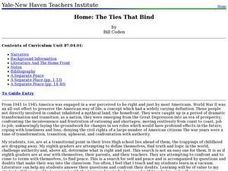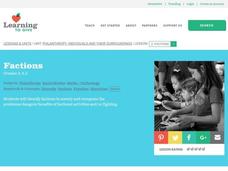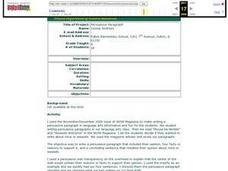Curated OER
SURVIVING A COSMIC INVASION
Young scholars read periodicals relating to radioacitivity and interpret a Geiger Counter. They work in small groups, share information and help each other explain the Geiger Counter. They discover the relationship distance to...
Curated OER
Poetry
Students apply reading comprehension skills to poetry and synthesize the information to create a new piece of work.
Curated OER
Home: The Ties That Bind
Students read two novels, The Human Comedy and A Separate Peace and an autobiographical memoir, Farewell to Manzanar. They focus on the difficulties faced by the teenage protagonists in order to set up a connection between adolescence...
Curated OER
Illinois Entice Spoken Here
Eighth graders name a prairie animal when their name is called for attendance each day. They read books about Illinois or related topics. At present we have read Illinois, A Rookie Read About Geography Book by Allan Fowler.
Curated OER
Summing it all Up...In Your Own Words
Learners observe and demonstrate the steps to identifying the main ideas of a text. They listen to the teacher read a paragraph and model the steps of summarizing the main idea. Students then independently read a different paragraph...
Curated OER
Very Hungry Caterpillar
Students read "the Very Hungry Caerpiller" by Eric Carle and create their own caterpillers using the same art techniques found in the book in this excellent early elementary lesson. Included with the lesson is a vocabulary list and a...
Curated OER
Protest Art in Pre-Revolutionary Russia
High schoolers study the social class conflicts that existed during the Russian Revolution by reading the short stories of Anton Chekov and Leo Tolstoy. They analyze the stories to find criticisms of pre-Revolutionary Russia before...
Curated OER
Factions
Students investigate factions in society. In this factions lesson plan, students learn the definition of factions before breaking into groups. They listen to a read aloud of The Butter Battle Book and describe what happens to the...
Curated OER
Forensic Entomology: What the Blowfly Saw
Learners read a paragraph describing various insects and decomposition rates, then fill in the table indicating when the three insects arrived or left the body. They write paragraphs explaining when the person died, and how they know.
Curated OER
Watsons Go To Birmingham--1963Patricia Wachholz
Students research the 1960s to prepare for reading the book, The Watsons Go To Birmingham, by Christopher Paul Curtis. They watch a documentary, create a timeline, and listen to music from the 1960s.
Curated OER
To Every Thing There Is A Season...
Students use the artwork by Robert Harris to examine the four seasons. In groups, they identify the clothing worn in the artwork and create a dance which resembles the painting. They also practice reading a thermometer and identify...
Curated OER
Minding the Media
Pupils reflect on the fairness of rating movies, television, radio, books, magazines, Web sites and other media. They submit their own entries for a media rating guide.
Curated OER
"My Hero"
Pupils investigate heroism through the ages. They complete an online Webquest, explore various websites, compare/contrast different types of heroes, answer discussion questions, and locate newspaper articles about someone they consider...
Curated OER
Using a Graphic Organizer to Critically Observe Televised News Broadcasts
Students compare two television news broadcasts. They discuss how to organize information when comparing two objects and read and discuss two books to create a Venn diagram to compare both books. After creating the diagram, they view...
Curated OER
Business Practices and Competition
Students identify the costs and benefits of large corporations and monopoly industries. Using the internet, they discover how businesses use different types of exploitation to maximize their profits. They read two articles about plants...
Curated OER
Recognizing Advertising Techniques
Learners explore advertising techniques. In this media awareness lesson, students read articles about foods and their links to childhood obesity. Learners also discuss propaganda techniques that advertisers use to sell certain foods.
Curated OER
Photo Editing and Photo Ethics
students investigate how to editphotos and understand the ethics of photo-editing in regard to photo-journalism. In this photo journalism lesson, students examine photos and photo spreads in various sources to identify editing...
Curated OER
Listening, Pronunciation and Vocabulary Practice
Students work together in reading groups. They practice pronouncing and spelling new vocabulary words. They listen to a recording to practice their comprehension skills.
Curated OER
Underground Rails: The New York City Subway System
Students explore the New York Subway system. They investigate its usefulness as mode of transportation for the people in the city and study its history compared to other city subway systems. They examine how the subway connects the...
Curated OER
Archaeology In The News
Students investigate the different articles of archaeology that is found in a variety of research and news resources. They read one of the selections and complete the worksheet as a guide to writing a summary of the article. Students...
Curated OER
Let's Sum it Up
Students review facts previously discussed about snakes and lizards and read pages in their science text book about snakes and lizards silently focusing on remembering important facts. They then complete a Venn diagram comparing snakes...
Curated OER
What's Important To You?
Second graders discuss as a class the importance of silent reading and describe some examples when it would be inappropriate if everyone read out loud. They read silently along as an article called, "Fighting a Mystery Illness" is read...
Curated OER
Summing It All Up
Students read articles and summarize the main points in this lesson. Students read a provided article from National Geographic Kids and create a web detailing the main points. They then use a six step process to write a summary of the...
Curated OER
Writing Persuasive Paragraphs
Fourth graders discover a fun-filled way to write persuasive paragraphs. After reading stories about mice and weasels, they choose which animal to be their topic. Students use a web outline to organize their opinion, four supporting...























